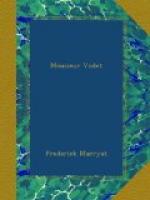I have selected this tradition out of many, as, allowing for metaphor, it appears to be a very correct epitome of the history of the Shoshones in former times. The very circumstance of their acknowledging that they were, for a certain period, slaves to that race of people who built the cities, the ruins of which still attest their magnificence, is a strong proof of the outline being correct. To the modern Shoshones, and their manners and customs, I shall refer in a future portion of my narrative.
CHAPTER V.
Every point having been arranged, I received my final instructions, and letters for the Governor of Monterey, to which was added a heavy bag of doubloons for my expenses. I bade farewell to the Prince and my father, and with six well-armed Indians and the Padre Marini, I embarked in a long canoe on the Buona Ventura river, and carried away by the current, soon lost sight of our lonesome settlement.
We were to follow the stream to the southern lakes of the Buona Ventura, where we were to leave our Indians, and join some half-bred Wachinangoes, returning to Monterey, with the mustangs, or wild horses, which they had captured in the prairies.
It was a beautiful trip, just at the commencement of the spring; both shores of the river were lined with evergreens; the grass was luxuriant and immense herds of buffaloes and wild horses were to be seen grazing in every direction. Sometimes a noble stallion, his long sweeping mane and tail waving to the wind, would gallop down to the water’s edge, and watch us as if he would know our intentions. When satisfied, he would walk slowly back, ever and anon turning round to look at us again, as if not quite so convinced of our peaceful intentions.
On the third night we encamped at the foot of an obelisk, in the centre of some noble ruins. It was a sacred spot with the Shoshones. Their traditions told them of another race, who had formerly lived there, and which had been driven by them to the south. It must have been ages back, for the hand of time, so lenient in this climate, and the hand of man, so little given to spoil, had severely visited this fated city.
We remained there the following day, as Padre Marini was anxious to discover any carvings or hieroglyphics from which he might draw some conclusions; but our endeavours were not successful, and we could not tarry longer, as we were afraid that the horse-hunters would break up their encampments before we arrived. We, therefore, resumed our journey, and many were the disquisitions and conjectures which passed between me and the holy father, as to the high degree of civilization which must have existed among the lost race who had been the architects of such graceful buildings.
Four days more brought us to the southern shore of the St. Jago lake. We arrived in good time, dismissed our Indians, and having purchased two excellent mules, we proceeded on our journey, in company with the horse-hunters, surrounded by hundreds of their captives, who were loudly lamenting their destiny, and showed their sense of the injustice of the whole proceeding by kicking and striking with their fore-feet at whatever might come within the reach of their hoofs. Notwithstanding the very unruly conduct of the prisoners, we arrived at Monterey on the sixth evening.




